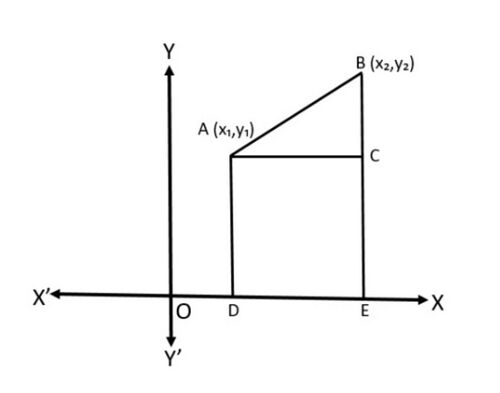दूरी-सूत्र: Difference between revisions
No edit summary |
No edit summary |
||
| Line 1: | Line 1: | ||
The distance formula, in coordinate geometry is used to find the distance between the two points in an <math>XY | |||
</math> plane. The distance of a point from the <math>y- | |||
</math>axis is called its <math>x- | |||
</math>coordinate, or abscissa. The distance of a point from the <math>x- | |||
</math>axis is called its <math>y- | |||
</math>coordinate, or ordinate. The coordinates of a point on the <math>x- | |||
</math>axis are of the form <math>(x,0) | |||
</math>, and of a point on the <math>y- | |||
</math>axis are of the form <math>(0,y) | |||
</math>. To find the distance between any two points in a plane, we will use the Pythagoras theorem. | |||
== What is the distance formula? == | |||
The distance formula is the formula, which is used to find the distance between any two points, only if the coordinates are known to us. These coordinates could lie on <math>x- | |||
</math>axis or <math>y- | |||
</math>axis or both. Suppose, there are two points, say <math>A | |||
</math> and <math>B | |||
</math> in an <math>XY | |||
</math> plane (see Fig. 1) The coordinates of point <math>A | |||
</math> are <math>(x_1,y_1) | |||
</math> and of <math>B | |||
</math> are <math>(x_2,y_2) | |||
</math>. | |||
[[File:Distance Formula.jpg|alt=Fig 1 - Distance Formula|none|thumb|500x500px|Fig 1 - Distance Formula]] | |||
Then the formula to find the distance between two points <math>AB | |||
</math> is given by | |||
<math>AB=\sqrt{(x_2-x_1)^2+(y_2-y_1)^2 } | |||
</math> | |||
== Distance Formula Derivation == | |||
Let us find the distance between two points <math>A(x_1,y_1) | |||
</math>and <math>B(x_2,y_2) | |||
</math> shown Fig.1 | |||
Draw <math>AD | |||
</math> and <math>BE | |||
</math> perpendicular to the <math>x- | |||
</math>axis. A perpendicular from the point <math>A | |||
</math> on <math>BE | |||
</math> is drawn to meet it at the point <math>C | |||
</math>. | |||
Then, <math>OD=x_1 | |||
</math> , <math>OE=x_2 | |||
</math>. So, <math>DE=x_2-x_1=AC | |||
</math>. Also, <math>EB=y_2 | |||
</math> , <math>EC=AD=y_1 | |||
</math>. Hence <math>BC=y_2-y_1 | |||
</math> | |||
Now, applying the Pythagoras theorem in <math>\bigtriangleup ACB </math> , we get | |||
<math>AB^2=AC^2+BC^2 | |||
</math> | |||
<math>AB^2=(x_2-x_1)^2+(y_2-y_1)^2 | |||
</math> | |||
<math>AB=\sqrt{(x_2-x_1)^2+(y_2-y_1)^2} | |||
</math> is the distance formula. | |||
=== Example === | |||
Find the distance between the two points <math>A(1,2) | |||
</math> and <math>B(3,4) | |||
</math> | |||
'''Solution:''' | |||
Let <math>A(1,2)=(x_1,y_1) | |||
</math> | |||
<math>B(3,4)=(x_2,y_2) | |||
</math> | |||
Distance between the two points <math>A | |||
</math> and <math>B | |||
</math> | |||
<math>AB=\sqrt{(x_2-x_1)^2+(y_2-y_1)^2} | |||
</math> | |||
<math>AB=\sqrt{(3-1)^2+(4-2)^2} | |||
</math> | |||
<math>AB=\sqrt{4+4}=\sqrt{8}=2\sqrt{2} | |||
</math> | |||
[[Category:निर्देशांक ज्यामिति]][[Category:गणित]][[Category:कक्षा-10]] | [[Category:निर्देशांक ज्यामिति]][[Category:गणित]][[Category:कक्षा-10]] | ||
Revision as of 09:26, 19 June 2024
The distance formula, in coordinate geometry is used to find the distance between the two points in an plane. The distance of a point from the axis is called its coordinate, or abscissa. The distance of a point from the axis is called its coordinate, or ordinate. The coordinates of a point on the axis are of the form , and of a point on the axis are of the form . To find the distance between any two points in a plane, we will use the Pythagoras theorem.
What is the distance formula?
The distance formula is the formula, which is used to find the distance between any two points, only if the coordinates are known to us. These coordinates could lie on axis or axis or both. Suppose, there are two points, say and in an plane (see Fig. 1) The coordinates of point are and of are .
Then the formula to find the distance between two points is given by
Distance Formula Derivation
Let us find the distance between two points and shown Fig.1
Draw and perpendicular to the axis. A perpendicular from the point on is drawn to meet it at the point .
Then, , . So, . Also, , . Hence
Now, applying the Pythagoras theorem in , we get
is the distance formula.
Example
Find the distance between the two points and
Solution:
Let
Distance between the two points and
